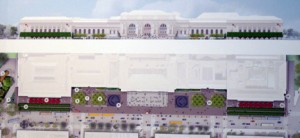March 12, 2012 – Public Design Commission
24273, 24370, 24371
Reconstruction of the Rieglemann Boardwalk, Brighton Beach and Coney Island Beach
 The Historic Districts Council is the advocate for New York City’s designated historic districts and neighborhoods meriting preservation. HDC regularly reviews projects affecting historic properties which are subject to public review by municipal agencies from the perspective of protecting the historic, cultural or architectural significance of the project site.
The Historic Districts Council is the advocate for New York City’s designated historic districts and neighborhoods meriting preservation. HDC regularly reviews projects affecting historic properties which are subject to public review by municipal agencies from the perspective of protecting the historic, cultural or architectural significance of the project site.
HDC has long been concerned about the preservation of historic Coney Island, and one of the key pieces to its special sense of place is the boardwalk. Built a few years after the subway opened here and began bringing up to a million visitors each summer day, the Rieglemann Boardwalk has been a “small-l” landmark of the beach for nearly a century. Much like the historic paving of TriBeCa or the Gansevoort Market area, the boardwalk enhances its location’s atmosphere and benefits visitors, businesses, and residents.
Concrete in place of wooden planks does not make a boardwalk, it makes a sidewalk, a very different New York City environment. We cannot stress enough the profound effect this proposed change will have on 1,000,000 people daily. At the height of the summer, one million people have actual physical contact with the historic resource in question. More than just looking at a historic building or reading an interpretive sign, walking on the Boardwalk is a visceral sensory connection to Coney Island’s history – which, in the ever-present figure of George Tilyou’s Steeplechase Funny Face, New York City is extensively using as a spur and a hook for the area’s revitalization plans. This is a massive failure of stewardship and a profound destruction of history. New York possesses this precious resource – an object which effortlessly evokes a specific ambience and distinct sense of place, and the Parks Department is proposing to destroy it.
Other, more sympathetic alternatives to the existing rainforest wood such as sustainable domestic hardwoods, recycled structural composites, or thermally modified hardwoods should be considered instead. True boardwalks continue to be used in other beach sites up and down the seaboard, and nothing less than that would be appropriate for the fabled beaches of New York City.
24393
1000 Fifth Avenue – Metropolitan Museum of Art
Reconstruction of the plaza, including the fountains and the south garage entrance
 The Historic Districts Council is the advocate for New York City’s designated historic districts and neighborhoods meriting preservation. Its Public Review Committee monitors proposed changes within historic districts and changes to individual landmarks and has reviewed the application now before the Commission.
The Historic Districts Council is the advocate for New York City’s designated historic districts and neighborhoods meriting preservation. Its Public Review Committee monitors proposed changes within historic districts and changes to individual landmarks and has reviewed the application now before the Commission.
HDC finds that there are a number of admirable features in this proposal for the Metropolitan Museum of Art including a lighting scheme that enhances and respects the architecture of the landmark, a state of the art planting systems that will ensure the health of new trees, and the retention of the 1970, Roche and Dinkeloo designed grand stair case. We feel though that the general tone of the project, wiping the slate clean and starting over, to be an unfortunate one. Rather than demolishing the 1970 plaza (designed and installed for the institution’s centennial and a symbol of the new era of a lively, engaging museum), it should be restored – the paving and fountains repaired, new trees placed in improved planting conditions – and then enhanced to meet the museum’s continuing needs. Signage can be used to direct visitors to the ground floor entrances, new seating can be installed and even kiosks can be considered within the basic plans of the existing design.
The proposed seems to be an awful lot of pieces that try to bring Central Park around to the Fifth Avenue façade, at times obscuring the museum itself. In particular, the solid massing of the aerial hedges would block views of a building meant to be admired. Although similar trees are seen in McKim, Meade and White drawings (which are filled with fanciful landscaping that never existed), the trees are next too, not in front of, the masterpiece to which the firm contributed. Roche and Dinkeloo’s design acknowledged the fact that the front of the museum is its urban face while the other three sides are surrounded by the park. One of the joys of walking around this city is coming up or down Fifth Avenue (as most pedestrians approach the museum, a factor which went into the design of the pyramidal, entrance staircase in 1970) and encountering the landmarked building emerging out of the forest of Central Park. To install trees and plantings all over the plaza would drastically change this experience.